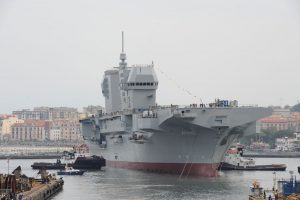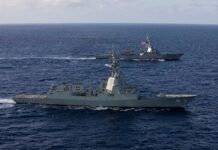By Luca Peruzzi

With a ceremony attended by Italy’s President of Republic Sergio Mattarella, Government and highest military authorities, welcomed by Fincantieri’s Chairman Giampaolo Massolo and CEO Giuseppe Bono, the Italian shipbuilding has launched today the LHD Trieste at Castellammare di Stabia, near Naples, European Defence Review reports.
“Developed to project and sustain – in the crisis areas – the Italian Navy’s amphibious force and the Italian Armed Forces’ Joint National Force Projection from the Sea including Italian Navy’s and Army’s forces, as well as the Italian Civil Protection in humanitarian and disaster relief operation, thanks to her capability to also provide potable water, electrical power and hospital support”, as remarked by the Italian Minister of Defence, Elisabetta Trenta, the new LHD Trieste “will further enhance the Italian Armed Forces’ joint and combined operations capabilities in support of both NATO and EU”, added Italian Chief of Defence, General Enzo Vecciarelli.
“The new LHD will replace the Garibaldi amphibious helicopter and STOVL-aircraft carrier, maintaining all her capabilities in addition to the well-dock and all the expanded transport and amphibious capabilities including an extended hospital and C4I facilities”, explained Vice Admiral Valter Girardelli, Italian Navy’s Chief of Staff. The new LHD will be equipped to operate and support the new Lockheed Martin F-35B STOVL aircraft, and will be delivered in June 2022, with a full aviation capability. Although rumors about the presence of a ski-jump had been around for some time, at the launch ceremony Vice Admiral Girardelli confirmed for the first time that the ship will be fitted with that system, which will allow to fully exploit the F-35B capabilities.
With a 33,000 tonnes full load displacement, a length and beam of respectively 245 and 36 meters, the new Trieste LHD is equipped with a COmbined Diesel or Gas (CODOG) with electric motors propulsion system including two Rolls-Royce MT30 gas turbines, two MAN 20V32/44R diesel engines and two electrical motors on two shafts with conventional rudders and controllable pitch propellers, offering a maximum speed of respectively 25, 18 and 10 knots. Endurance reaches 7,000 NM at 16 knots. Accommodations include 1064 berthing for a 460 complement and the remaining aviation, embarked C4I and amphibious unit personnel.
The LHD presents a full-length flight deck with a two-structures island, two 40 tonnes capable elevators and the capability to accommodate both Italian Navy and Army helicopters in addition to F-35 STOVL aircraft, CH-53s and V-22 tiltrotors type platforms. The hangar can accommodate both aircraft and vehicles while the forward vessel area features a fully equipped NATO Role 2-E hospital area and the amphibious C4I staff area. The underneath main garage and 50×15 meters stern well deck can respectively accommodate wheeled and armored vehicles weighting up to 62 tonnes and up to four Cantiere Navale Vittoria-built LCMs.
While Fincantieri’s Seastema company provides the integrated platform management system (IPMS), Leonardo supplies the combat system centered on the new generation SADOC Mk 4 Command Management System (CMS) and a sensor suite including the new X-band Kronos StarFire four fixed-faces EASA radar, and the new L-band Kronos Power Shield AESA long-range surveillance radar with anti-ballistic missile capabilities, conformal IFF, a distributed static staring IRST (DSS-IRST) as well as an integrated communications suite with multiple data links processor. The Elettronica group provides the RESM/CESM/RECM suite with two Leonardo ODLS-20 multirole decoy launchers and the Black Snake towed-array torpedo detection system, in addition to obstacle avoidance sonar and surface long-range non-lethal defence systems. The Inner Layer Defense System is based on three 76/62 Super Rapido gun-mounts with Strales guided ammunition and three dual-band radar-EO/IR NA-30S Mk2 fire control system and remotely-controlled 25/80 mm smaller guns.




